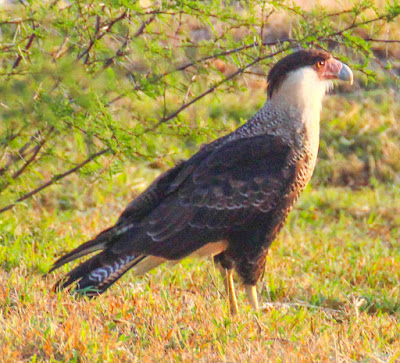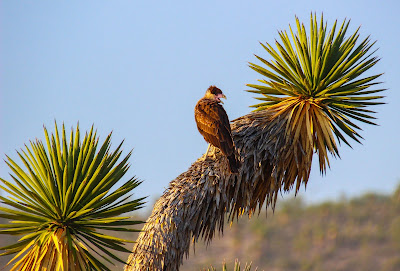The northern crested caracara, also known as the crested caracara, has a black body, wings, crest and crown; white neck, rump and wing patches; a white tail and breast with black barring and the tail has a broad terminal band; the bill is thick, gray and hooked; the facial skin is yellow to orange red, depending on age and mood; and the legs are yellow.
 |
| This young adult caracara takes flight in the early morning light. |
 |
| The same bird standing on the ground. |
Immature birds are more brown; have a buff neck and throat; a pale breast streaked or mottled with brown; grayish white legs; and grayish or dull pinkish purple facial skin.
 |
| This youngster looks like it just barely left the nest. |
 |
| The youngster in flight. |
 |
| A juvenile on a yucca plant or joshua tree. |
They are found in small portions of the southern U.S., including portions of southern Arizona, Texas and south/central Florida. It is much more widely distributed in Mexico through Central America and down into northern South America.
 |
| Distribution of the northern crested caracara from Wikipedia. |
I recall looking at pictures of the caracara in my youth and wanting to see them. More recently, I saw pictures of them from Puerto Penasco, Sonora, Mexico; Melbourne, Florida; and Big Bend National Park in Texas and hoped to no avail to see them while visiting those areas.
On a recent visit to northeastern Mexico with my nephew, John, I expressed my interest in seeing a caracara. On a long stretch of open country between Zacatecus and San Luis Potosi we spotted several from our car. One in particular had the unmistakable reddish facial skin I could see as it flew along parallel to our car. These were the dark adults with the more colorful facial skin. After spending the night in San Luis Potosi, with a long drive to Ciudad Victoria the next day, I put my 500 mm lense on my camera and placed it on the back seat of the car in the hope that we might see another caracara on our drive and somehow be in a position to photograph it.
 |
| More photos of the first caracara in flight. |
Fortunately, several opportunities arose. The first was on a very nice toll road, early in the morning, where we were virtually alone. I spotted a caracara standing on the ground next to a bridge over the road. I stopped, backed up the car and got a number of photos as it stood on the bridge, then flew to a spot in the distance and finally flew away.
About 30 minutes later I spotted another caracara standing on the other side of the road. I stopped, did a u-turn, then pulled up behind it and then got out of the car. It was a very brown juvenile. It flew to a place where there were several more caracaras. I'm guessing that they had just recently left their nests as I spotted mama standing at some distance watching them and me.
 |
| Mama caracara. |
This was a thrill. My photos are not the best and I would liked to have gotten better photos of an adult, but just seeing them in the wild was worth the hassle of bringing my long telephoto lens on the trip.



I'm sure I don't know anyone else who has dreamed of seeing a caracara in the wild since his childhood. Glad that dream was fulfilled.
ReplyDeleteYeah I am sure some of the locals thought we were crazy but Uncle Bob was happy.
ReplyDelete